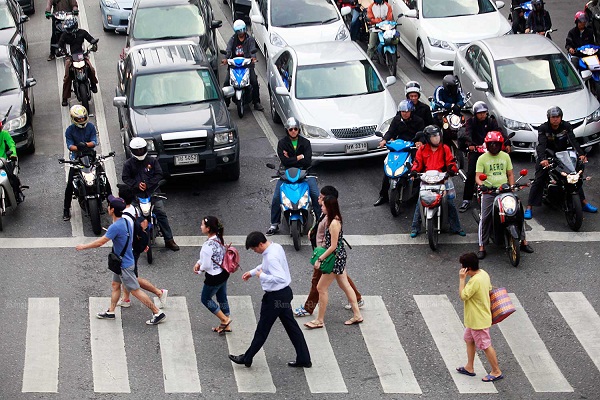
I'll maneuver as necessary so as not to hit them, if they come close, but I'm not stopping and letting them cross unless I'm in a good mood. Step off the curb opposite me while I'm moving and expect me to stop? Think again. I won't hit them, but I'm not waiting for them either. I'll start moving if they're trying to cross, and i have the right of way, and force them back up on curb.

BPD runs Operation Crosswalk, not Operation Jaywalk. Fail to yield while they're in a crosswalk and a cop can write you a ticket. It means you don't have to stop and can legally go around them, or force them back up on the curb and a cop can't write a ticket. That doesn't mean you are allowed to hit them. If they are not within a crosswalk within 10' of you there is no such requirement to stop. Then you are required to stop and yield right of way. If you were in a pedestrian accident due to the negligence of someone else, it is important to contact a San Diego pedestrian accident attorney immediately for legal advice.Click to expand.The law is only about marked crosswalks and if they're within 10' of your travel lane in that crosswalk without traffic control devices.
#Does the pedestrian always have the right of way driver#
If traffic is present, a pedestrian must yield the right of way to vehicles that present an “immediate hazard.” It’s illegal for pedestrians to leave the curb or sidewalk and enter the path of an oncoming vehicle if the vehicle doesn’t have sufficient time to stop safely. The driver of a vehicle shall yield the right-of-way slowing down or stopping if need be to yield to a pedestrian crossing the roadway within a crosswalk. It’s legal for a pedestrian to cross the road at any point if they are not at a marked crosswalk or an intersection, as long as there’s no traffic. This type of violation is not a crime but can carry a fine of up to $200. Even when diagonal crossings are permitted, pedestrians should take great care to watch for vehicles and only cross when they have the right-of-way.įailing to use a crosswalk when one is available can result in a ticket for jaywalking. This prevents pedestrians from crossing an intersection diagonally, which is illegal unless there is a crosswalk or a traffic control officer that allows it. If there is a crosswalk at an intersection with traffic lights, traffic signals, or police officers, pedestrians must cross within it. They must also not attempt to run through a Do Not Walk sign if traffic is approaching, leave the curb suddenly, or unnecessarily stop or delay traffic. If a vehicle is already in the crosswalk, pedestrians must let them pass. Pedestrians must cross the street safely. It can be considered a crime if a driver fails to yield to a blind pedestrian, and they may face up to six months in jail and a fine of up to $1,000. Special Rules for Blind Pedestriansīlind pedestrians using a cane or a guide dog always have the right of way at all intersections. If a vehicle must turn into a driveway and pass over a sidewalk, the driver must yield to pedestrians. Pedestrians also have the right of way when walking on a sidewalk. If there is no countdown clock, pedestrians are not supposed to enter the crosswalk if the signal is blinking. Where a crossing signal has a countdown clock, pedestrians can begin crossing when the light is blinking but must reach the other side before it turns steady. If an intersection doesn’t have pedestrian signals, pedestrians must obey traffic signals and only cross at a green light when the roadway is clear. Motor vehicles must slow down and yield to pedestrians. Pedestrians have the right of way as long as they use a crosswalk and obey Walk and Do Not Walk signs. Right of Way Laws in CaliforniaĪccording to California Law, the driver of any vehicle must yield to pedestrians. Under California law, pedestrians are required to adhere to the following. These regulations reduce the risk of a crash, and when one does occur, the laws regarding pedestrians play a big part in determining who is at fault for an accident. Just like drivers, pedestrians in California are responsible for following traffic and safety laws at all times.


 0 kommentar(er)
0 kommentar(er)
